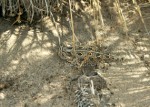
Click On Picture for Larger Image
Texas Horned Lizards
Author: Patsy Jones
 Click On Picture for Larger Image |
Species: Phrynosoma cornutum |
Description:
The Texas Horned Lizard looks fearsome with its two enlarged horns at
the back of the head, daggerlike spikes on each of its spots and two rows of spiky fringe scales on the
sides of its body. However, they are small lizards, typically growing up to 7.1 inches (18 cm) in size.
Their background color may be tan, yellow, or some other shade that closely matches the ground soil they
live on. They have dark markings on either side of a conspicuous light-colored stripe running down the
middle of their back. Each marking is punctuated with a dark spike. They also have darker markings
radiating outward from each eye.
They have a flattened, toadlike body, running very close to the ground. This makes them somewhat awkward
and slower than other desert lizards.
Geographic range:
Texas Horned Lizards have a geographic range that extends over
most of Kansas, Oklahoma, Texas, and eastern and southern New Mexico, generally in areas below 5,000 feet
elevation. They are also found extensively in northern and eastern Mexico.
Habitat:
Texas Horned Lizards inhabit arid and semiarid open country with dominant plant species of bunch grass, cacti, juniper, acacia or mesquite. They also like mountains, foothills and
alluvial plains. They can be found also in short grass prairie, pinon-juniper woodlands, and open pine
forests.
They like areas with loose soil so they can bury themselves to escape heat and predation. Texas Horned
Lizards will often seek shelter under bushes and rocks or inside other animals' burrows.
Food Web:
The Texas Horned Lizards' diet is mostly ants, although they will also eat
other insects such as beetles and grasshoppers or spiders. They will often sit next to an anthill and eat
each worker ant as they march out one by one. Their digestive system is designed to digest ants which
actually have very little nutritional value. In addition, they are often mobbed by angry ants. However, the
Texas Horned Lizard has evolved an antitoxin specifically for ant venom.
They might be a tasty morsel for a hawk, snake, or other predator except they are difficult to see when
they stand motionless against a background of rocks and stones that look exactly like them. If a predator
does decide to make them a meal, they can puff themselves up, extending their spikes even further to
discourage the predator.
Reproduction and Development:
Texas Horned Lizards lay 13-45 eggs from late spring
to early summer.
Behavior:
These lizards are diurnal, often seen about during the day. Because they
have such a flattened body shape, they can cool themselves by tilting their body away from the hot sun and
allow the heat to escape from the shaded surfaces. Texas Horned Lizards have a slow metabolism and so rely
mostly on camouflage to protect themselves from predators. They often remain motionless when predators are
around and are difficult to spot against the soil's background. They will only move just before they are
stepped on. To find a horned lizard, search the ground near anthills where they wait for food, or look for
their tracks. When they are picked up, they will often gulp air and puff up or jab with their horns for
defense. Some species of horned lizards will also squirt out a stream of blood from a large sinus gland
behind their eyes, startling the potential predator.
Conservation:
Although they are popular for pets, Texas Horned Lizards do not do
well in captivity since they need a large continuous supply of ants. It is illegal in New Mexico to export
any Horned Lizard for the pet trade. They are not considered endangered, but in some parts of their range,
especially south Texas, their population numbers are declining drastically.
Taxonomy:
Kingdom: Animalia
Phylum: Chordata
Subphylum: Vertebrata
Class: Reptilia; Reptiles
Order: Squamata
Family: Iguanidae
Genus: Phrynosom
Species: Phrynosoma cornutum
References:
Peterson, Roger T. and Stebbins, Robert C., Peterson Field Guides:
Western Reptiles and Amphibians, 1985, Houghton Mifflin Co., Boston.
Tweit, Susan J., The Great Southwest Nature Factbook, 1992, Alaska Northwest Books, Anchorage.
Williamson, Michael A., Hyder, Paul W., and Applegarth, John S., Snakes, Lizards, Turtles, Frogs, Toads,
and Salamanders of New Mexico—A Field Guide, 1994, Sunstone Press, Santa Fe.